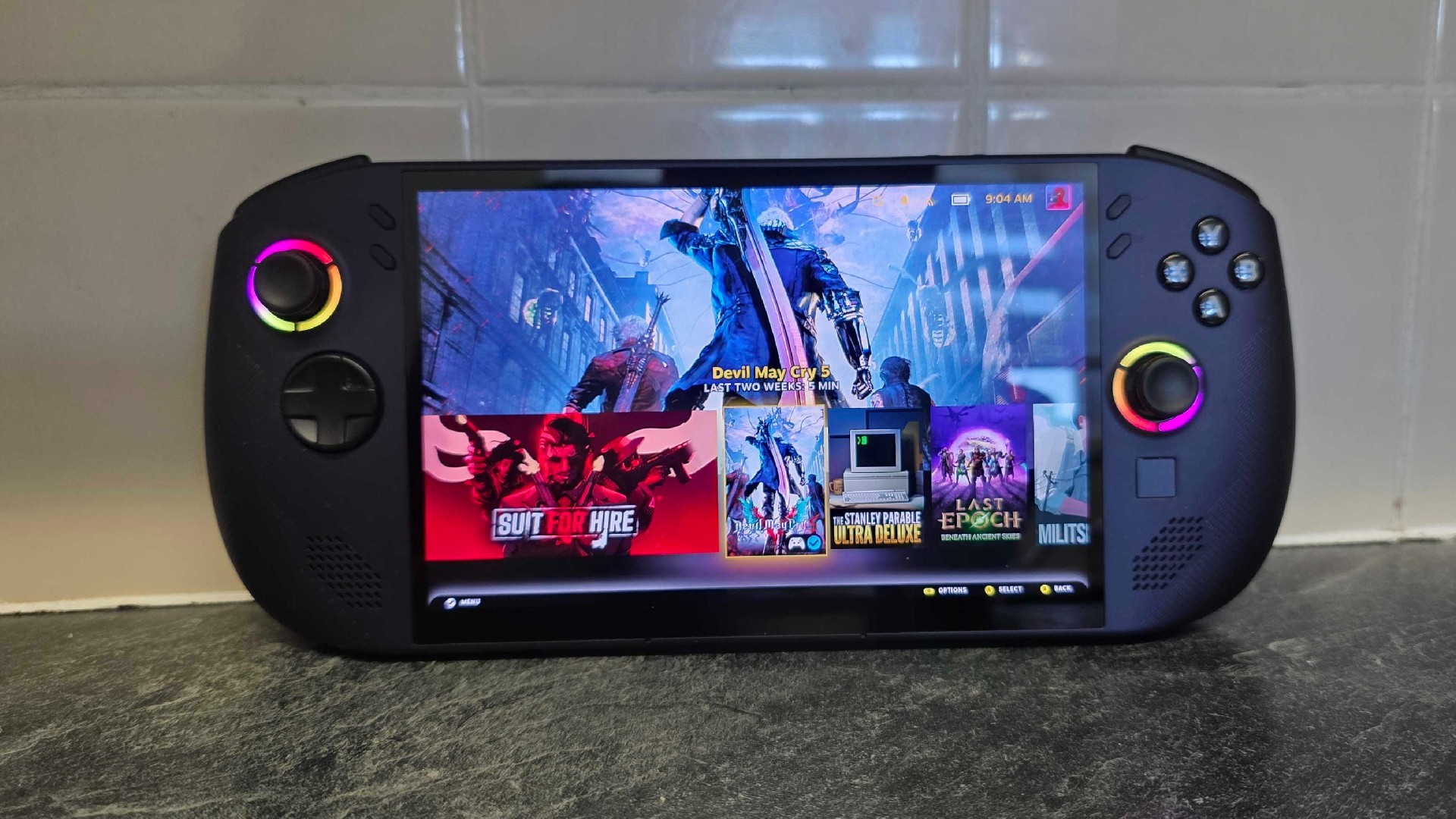Verdict
The Lenovo Legion Go S with SteamOS is a powerful handheld console that delivers great performance with a comfortable design. While a small trackpad and disappointing speakers make for some minor gripes, it’s an impressive rival that can stand against Valve’s Steam Deck.
- Great, comfortable design
- Brilliant performance
- Gorgeous display
- Trackpad is pointless
- Speakers aren’t the best
While the handheld PC market has experienced rapid growth in recent years, with challengers popping up in an attempt to dethrone Valve’s Steam Deck, many use Microsoft’s Windows as an operating system, which, for all intents and purposes, isn’t as good as Steam Deck’s aptly titled SteamOS. It’s taken a while, but another competitor is finally using a Linux-based OS, and it’s a big part of what makes the Lenovo Legion Go S with Steam OS so good.
Capable of running all of the best Steam Deck games like you’d expect, the Lenovo Legion Go S is an interesting rival to the top handheld consoles right now. It loses its funky feature of detachable controllers à la the Switch in favor of the more commonplace handheld PC design we’ve come to know and love. Yet, while it does have some issues that the Lenovo Legion Go 2 could fix, it proves that maybe SteamOS or other handheld-focused operating systems continue to be the way to go.
Why you can trust our advice ✔ At Pocket Tactics, our experts spend days testing games, phones, tech, and services. We always share honest opinions to help you buy the best. Find out how we test.
Specs
| CPU | AMD Ryzen Z2 Go / Z1 Extreme |
| GPU | AMD Radeon Graphics |
| RAM | 16GB / 32GB LPDDR5X |
| Display | 8-inch WUXGA IPS (1920 x 1200), up to 120Hz |
| Battery | 55.5WHr |
| Storage | 512GB or 1TB SSD |
| Weight | From 740g |
| Dimensions | 22.6 x 127.55 x 299mm |
At first glance, the Lenovo Legion Go S may seem like a simple cut-and-paste Steam Deck. It has the same amount of RAM, a similar AMD chipset (although it’s not a dedicated chipset but rather the Ryzen Z2 Go), and a familiar design. However, the Lenovo Legion Go S sports an impressive 1,920 x 1,200 resolution in an 8-inch display, while also offering Variable Refresh support. It also has a 120Hz refresh rate, which is 30Hz higher than the Steam Deck’s 90Hz.
It’s not going to play Cyberpunk 2077 on Overdrive mode, but as far as handhelds go, it’s an impressive range of hardware that makes for a good experience, whether you’re on the go or sitting comfortably on the couch.
Price
The Lenovo Legion Go S (SteamOS) with the Z2 Go chipset starts from $599.99 / £499, while the powerful Z1 Extreme variant starts from an expensive $829 price tag. These prices aren’t anything too distinct from other options on the market, even if I’m slightly concerned that the Z1 Extreme chip’s 2023 release date puts it in the older bracket. It makes me a little anxious that any model with this chipset may find itself struggling sooner rather than later.
Despite being weaker, the Z2 Go has been a great experience facing most of the games I played, which you can read about further below, and with a smaller price tag (one that will likely drop in sale periods), I’d argue it’s the better option.
Operating system and software
Unlike the standard Lenovo Legion Go S, which comes with Windows 11, the SteamOS version comes with, well, Valve’s Linux-based operating system found on the Steam Deck. It’s the first non-Valve handheld to ship with SteamOS, and the difference is substantial. Setup is easy, the interface is console-like in design, and the ease of all of that makes it ridiculously approachable.
That does mean it comes with the typical SteamOS limits. Any game that only runs on Windows, such as Destiny 2, won’t work on the Lenovo Legion Go S, the same way that it won’t run on Valve’s handheld. However, the difference between the operating systems is night and day – SteamOS takes the win away from Windows, and Lenovo’s latest console is all the better for it.

That also means that, like Valve’s handheld, the Lenovo Legion Go S is very customizable thanks to SteamOS features like the Decky Loader plugin. I’m not someone who usually cares about how customizable a console or PC is, but the vast amount of features and changes you can make have turned me into a designer of sorts, as I attempt to make the perfect Steam interface to suit my needs.
Performance
Nothing matters if the Lenovo Legion Go S can’t play games well, and fortunately, that’s not an issue. As I mentioned before, so long as the games are compatible with SteamOS, it’s fairly simple to run any Steam Deck Verified titles on the Lenovo Legion Go S. Of course, you’re still limited to games that don’t have high system requirements, many of which remain categorized as ‘Unsupported’ by Valve, especially triple-A games with high visuals.
I spent hours playing anything from the best DC games, like Gotham Knights – I’m sure our very own Sam Comrie will be happy – to MMOs like Final Fantasy 14, and I had very few issues. The best indie games ran with ease, as I dominated hallways in Suits for Hire or as I breezed through enemies in I Am Your Beast. It was a consistently smooth experience.

Admittedly, I did run into a couple of games that didn’t run so well, which wasn’t unexpected. For example, The First Descendant ran with stutters and frame drops, despite the low visual quality that the system recommended. But playing some of the best RPGs like Baldur’s Gate 3 (which I finally started on the Lenovo Legion Go S after almost two years of delaying) made for a great time.
Despite the Z2 Go chipset being weaker than the more expensive and more powerful AMD Ryzen Z1 Extreme chip, I had a great time with the Lenovo Legion Go S. SteamOS’s simplicity and easy-to-change settings in both games and the device itself made the experience all the more accessible, and whether you have time to mess with the features that SteamOS offers, like TDP limits or frame limits, or not, you’re in for a good time regardless.
That does bring us to the weakest part of the Lenovo Legion Go S (small trackpad notwithstanding). The battery life isn’t great. It’s unsurprising, considering how much some of these games draw from the battery to keep running, and while some indie games may get two to two-and-a-half hours out of the console, you’re not going to get much more than two hours out of an older triple-A game without some sorcery.
Admittedly, this does depend on a lot of features, many of which will be up to you. For example, you may prefer your LEDs off and your settings constantly low, and you may be able to get more or less battery life out of the handheld. As it stands, it’s not top of the range, but it’s also not bottom of the barrel in this regard either. It’s pretty mediocre, which isn’t a surprising factor.

However, I was disappointed by the speakers, too. It’s nothing that the best gaming earbuds can’t alleviate, and when travelling, chances are you’ll be sporting some buds or some headphones instead of having your speakers on full (unless you can stand strangers’ looks with ease). But the speakers are very quiet until you reach around 75% volume, where they blast out loudly. It seems like there’s no real middle ground, and it’s either quite loud or far too quiet.
Design
As far as the actual design of the device, the Lenovo Legion Go S isn’t anything spectacular. The black chassis keeps it looking sleek, while the RGB rings around the sticks give it that gamer-fied look that most would expect, with the overall gamepad design sharing similarities with an Xbox controller, as opposed to the Steam Deck’s design.
A small (and I mean, small) trackpad lives below the right-hand analog stick, offering minor help for cursor movement. It’s practically redundant, and while I don’t find myself using the Steam Deck’s impressive trackpads as often as I wanted, they’re much better than having this tiny little square of – let’s be honest – nothingness.

All of the buttons and triggers feel responsive and clicky, giving you that instant satisfaction with each press. The Hall Effect sticks make for an anti-drift solution, and I’m happy that these types of sticks are becoming more commonplace, even if a few companies still refuse to make it a staple of their hardware (cough, cough, Sony and Nintendo).
The Legion Go S’ cooling system is fairly simple. The fans on the back take in air and expel it from the vents at the top of the device. It’s nothing special, but it does have its problems if you’re like me and have your legs up when sitting down, using your legs to keep the device comfortable – it’s a minor issue, though.

Despite the hefty weight of the Lenovo Legion Go S, which isn’t a unique factor among handheld PCs, it’s a very comfortable device to hold. The weight distribution is fantastic, allowing me to use the console for hours on end without issue, and the charging port being at the top allows me to enjoy the best action games without having to fiddle with a wire below, like the first iteration of the Nintendo Switch.
Display
The Lenovo Legion Go S has a very impressive display, and while it’s an IPS screen instead of an OLED, which would surely add some dollars to the price tag, it’s still a great experience. Decky Loader’s VibrantDeck plugin makes colors pop even further, but the out-of-the-box visuals are still good enough to play your favorite games without any issues.
I never had problems with the touchscreen’s responsiveness either, and after two weeks of testing, it’s never failed to get an instant response from those finger presses, so I can avoid scrolling through menu screens – or dealing quickly with the endless amounts of loot I obtain that I don’t need.
Sure, it’s not as vibrant or as gorgeous as handhelds with OLED displays, but it’s nothing short of impressive, with the 1,920 x 1,200 resolution offering great visuals on the 8-inch screen. The VRR helps against screen tearing and is something that Valve’s handheld truly lacks – and with the heightened 120Hz refresh rate, it’s truly great for playing those games with a high amount of smoothness.
Should you buy the Lenovo Legion Go with SteamOS?
Despite some minor gripes, the Lenovo Legion Go S with SteamOS is a brilliant handheld PC and a truly impressive console. Compared to the Windows options across the market, it’s a great experience right out of the box, with a simple setup method that gets you straight into your games and allows you to easily see which games work well on the handheld without diving into system requirements or messing around with Windows’ countless problems on a small device.
It does remove the uniqueness of the original Lenovo Legion Go, making it remarkably similar to competitors that are already available, but the SteamOS and comfortable design, as well as the impressive display, make it an instant contender for the throne against Valve’s very own Steam Deck. And, arguably, I’d say it’s better.
Alternatives
Steam Deck OLED
Unsurprisingly, the best alternative to the Lenovo Legion Go S is Valve’s reigning handheld, the Steam Deck OLED. With a vibrant, gorgeous display and the ability to play any games that you can enjoy on the Lenovo Legion Go S, it’s a fantastic handheld that remains the leading handheld PC. For more details, check out our Steam Deck OLED review.
ASUS ROG Ally X
If you don’t mind having Windows on your handheld but still want a comfortable design with performance to boot, the Asus ROG Ally X is my favorite Windows OS handheld on the market right now. While the OS is fiddly to deal with, and the price is fairly high, the Asus ROG Ally X is an impressive beast for an on-the-go companion. For the full lowdown on this one, see our Asus ROG Ally X review.
Source link
Mobile tech & hardware,Android,iOS




Average Rating